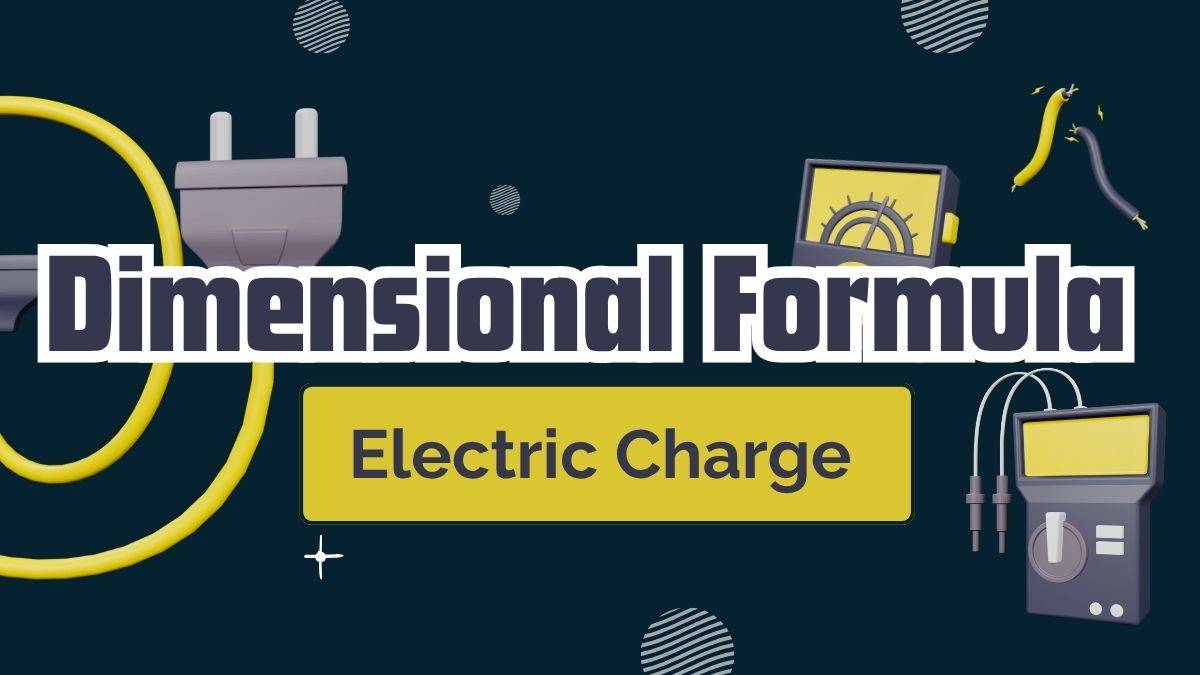Dimensional Formula of Electric Charge: How to Derive Easily
Most students can tell the dimensional formula of electric charge is [M⁰L⁰T¹I¹], but many get stuck while deriving it. But it's really easy. Check the four simple ways to do it below.
By universal standards, the dimensional formula of electric charge is [M⁰L⁰T¹I¹] or [M⁰L⁰T¹A¹]. M is for mass, L denotes length, T stands for time, and I tells us electric current.
A is the actual or official SI Unit of electric current denoting Ampere, and sometimes A is used instead of I, as A is the internationally accepted base unit.
It derives from the formula of electric current with respect to electric charge, which is Q = I×T. Q stands for total electric charge, I for electric current, and T for time. The same is also used for the SI unit of electric charge.
Below, we will explain a little more about the dimensional formula of electric charge, especially the simple derivation using concepts you already know from the Units and Measurement Class 11 Notes.
- How to Derive the Dimensional Formula of Electric Charge in 4 Steps
- Dimensional Formula of Electric Charge with a Simple Numerical Example
- Why You Must Learn the Dimensional Formula of Electric Charge
How to Derive the Dimensional Formula of Electric Charge in 4 Steps
To derive the electric charge’s dimensional formula, recall that’s used for checking the validity of any equation.
It’s quite effective, and deriving it is simpler than you think. We’ll take you step-by-step right here.
-
Start with the Definition of Electric Charge
Looking through the Electric Charges and Fields Class 12 Notes, you’ll learn that electric charge is current multiplied by time. The formula for electric charge is Q = I x T.
-
Write the Dimensional Formula for Current and Time
It is ideal to write down the dimensional formulas for current and time separately.
The dimensional formula for Current (I) alone is [M⁰L⁰T⁰I¹]. A is the SI Unit of electric current, as it’s the base unit.
Now, writing the dimensional formula for Time (T) is [M⁰L⁰T¹I⁰].
-
Multiply the Dimensions as the Product of the Electric Charge
As is evident from Q = I x T, we get
[Q] = [M⁰L⁰T⁰I¹] x [M⁰L⁰T¹I⁰]
-
Then Combine and Only Add the Exponents
When combining these, you just need to add to get the below result.
[Q] = [M⁰⁺⁰L⁰⁺⁰T⁰⁺¹I¹⁺⁰]
After adding, we get the dimensional formula for electric charge.
[Q] = [M⁰L⁰T¹I¹]
Another simplification for the dimensional formula for electric charge is [T¹I¹] or, simply, [TI] or more accurately, [TA].
Dimensional Formula of Electric Charge with a Simple Numerical Example
Let’s say, we need to know the electric charge of a current of 22 Amperes that’s flowing for 33 seconds.
To make the answer and the dimensional formula right, we use the basic electric charge formula.
Q = I x T = 22 A x 33 s = 726 C
(Where C is the SI unit of electric charge.)
The unit is clearly [A . s]. That maps straight up to [I x T] when we equate it dimensionally.
Both sides of the electric charge equation should match the dimensions.
- On the left, we have Electric Charge as Q in Coulombs, which tells us [A . s]
- To the right, we see Current × Time (A×s) is in [M⁰L⁰T¹I¹] or equivalently, [M⁰L⁰T¹A¹].
Now that’s verified.
Why You Must Learn the Dimensional Formula of Electric Charge
In competitive exams, such as JEE Mains, you may expect some application-based questions on dimensional formulas that cover concepts and numerical problems from both Class 11 and Class 12 Physics.
In such exams, you need to have some conceptual clarity on using dimensional analysis to prove which variables the formula is dependent on. It’s essential to be able to identify the relationships and how other physical quantities may change when base units are changed.
Example questions in exams and competitive tests to expect
- If Q = I × T, what will be the dimensional formula for the electric charge, Q?
- Using the formula for current density, J = IA , derive the dimensional formula of electric charge.
How does the electric charge dimensional formula help in exams?
- The dimensional formula for charge Q is [M⁰L⁰T¹I¹]. It can help derive the equation for total electric charge, which is Q = I x T. It practically confirms the relationship between Charge, Current, and Time.
- If you get an MCQ question on physics, asking which is the correct formula for charge, and only those with [T¹I¹] are correct, you can save time without having to second-guess others.
After finishing this blog, you may want to test your knowledge on what you have read and mastered right before your competitive tests.
Start practising the exemplar pages for the first chapters of Class 11 and 12th Physics. We, at Shiksha, have curated these pages with experts.

